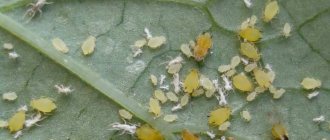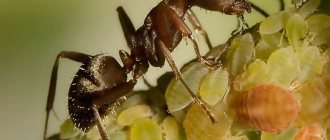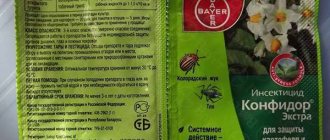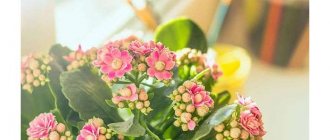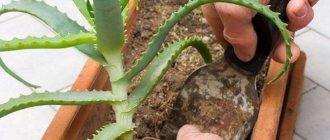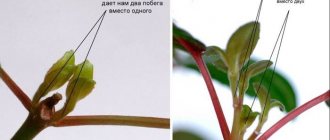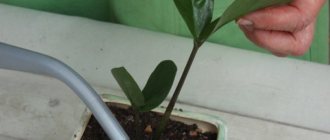Curling leaves, wilting buds, and the plant losing its attractiveness are the first signs of pests. To save the beauty on the windowsill, you need to know how to get rid of aphids on indoor flowers and prevent their appearance in the future. When fighting parasites, it is important to identify and eliminate the causes of the problem, and then destroy the pests using folk remedies or insecticides.
Aphids are a dangerous parasite that quickly adapts to any conditions and in a short time creates large colonies that destroy indoor plants. To save your home greenhouse, it is important to start pest control in a timely manner.
The article contains relevant and effective methods of combating aphids that will help save the plant and restore its attractiveness and vitality.
What harm can aphids cause to indoor flowers?
Aphids on indoor plants are a common occurrence. The main danger of insect activity is the destruction of vegetation. Aphids pierce the skin of the leaves and suck out the juice. Colonies of parasites attack young and adult plants.
Single individuals lead to the drying out of several leaves of the flower; with timely help, the plant can be saved. A large accumulation of aphids on one indoor plant leads to its death.
Folk remedies against aphids
In case of primary infection of a flower and a small number of insects, you can use folk remedies that are safe for both plants and humans.
Means to combat aphids:
- Treat the infected areas of the plant with a solution of laundry soap.
- Dilute kerosene with water and coat all the leaves with a brush with this solution, but you need to do everything in a ventilated area, and after a while wash the plant in running water.
- Infusions of fragrant plants are an excellent way to get rid of aphids. The following are suitable: tomatoes, tobacco, wormwood and celandine.
- The garlic infusion is mixed with aromatic soap and ash and sprinkled on the plants.
- Arrange water treatments for the infected plant, carefully using a shower to wash off the insects along with the water.
- While the plants are infected, sprinkle it with grass, tobacco and shag.
- Prepare onion infusion with soap.
- An infusion of citrus peels, they can also be dried and placed on the soil where the plant grows.
- You can spray the plant with an infusion of tomato leaves, soap and water. A very effective method of getting rid of various insects.
- Sometimes watering and spraying the plants with a weak solution of potassium permanganate can help. Just don’t overdo it, it can cause burns to the leaves and roots, and the plant will die.
5 Carnivore Plants You Can Grow at Home
If the above methods do not help, then use chemicals to combat aphids, which are purchased in special stores.
Signs of pest damage
It is easy to see the presence of aphids on a plant - upon inspection, syrupy traces appearing from pest secretions and other symptoms are visible on the foliage.
Read more about why aphids appear on plants in the article here.
The first signs of aphid infestation:
- The shoots curl and wither. Young specimens of domestic flowers suffer.
- The presence of black marks on the leaves. Aphids spread sooty fungus, which appears as dark spots.
- Clusters of insects are noticeable on the underside of the leaves.
- Opened flower buds look ugly.
- Some flowers do not open.
There are several types of parasites. At the same time, the methods of combating it depend on the type of aphid. At the first signs of damage, it is necessary to immediately get rid of aphids. To do this, you need to choose the appropriate method and take preventive measures.
White
Dicotyledonous plants are most susceptible to attack by white aphids. Parasites are rare on domestic flowers. Aphids, covered with white pollen, penetrate the root system and suck out the juice. The plant dies.
Green
The parasite has a pale green color. Settles on bushes and trees. Dangerous for decorative Chinese roses, lemons, etc. Before winter, the female lays eggs near the buds. In the spring, the larvae hatch and parasitize the plant.
Black
Black aphids are dark in color and their body length reaches 5 mm. To pierce the foliage, a proboscis is located on the body of the parasite, with the help of which the insect drinks juice. Black aphids reproduce at a high rate because they do not need to mate. The larvae appear on young shoots of indoor plants and eventually move to adult specimens of vegetation.
Yellow
The yellow aphid has a corresponding color. Prefers to settle on coniferous vegetation near the buds. The primitive parasite does not spread to neighboring plants. One generation is hatched per year. Therefore, yellow aphids are few in number.
Effective methods of controlling aphids on coniferous trees
Bloody
The blood aphid is native to America. In its homeland, the insect parasitizes in the bark of elm trees. On the territory of Russia, the insect is found in gardens, rarely on domestic vegetation. The body of the parasite is covered with wool-like waxy threads.
What kind of insect is this and why is it dangerous?
An aphid is a white, drop-shaped insect, no more than half a centimeter in length. There are winged and wingless ones.
Winged aphids are capable of moving to other plants . Wingless insects reproduce massively. Aphids pierce leaves and suck out life-giving juices, taking away nutrients from the plant and creating pockets for bacterial infection (you can learn more about what aphids feed on in this material).
Where does it come from and what plants does it affect?
Typically, aphids come indoors on other plants. This could be a bouquet of cut flowers or a purchased infected flower. Sometimes an insect can fly into a room while airing.
To detect aphids, you need to examine the leaves and stem from the inside, where the females lay eggs. The larvae look like small white specks.
White aphids attack dicotyledonous plants; legumes are especially susceptible to attack. White aphids overwinter on pistachio trees .
Favorable conditions for the reproduction of pests are dry soil and high temperatures.
How do aphids get into the house?
The most common type of aphid found on indoor plants is the aphid. Pests are located on the roots, leaves, stems and flowers of indoor plants.
Where and why do pests appear within the apartment:
- Purchase of an infected plant.
- Migration of parasites from the street on clothing or household items.
- Aphids enter from the street through open windows.
- Sticking of insects when airing flowers outdoors.
- The vital activity of ants, for which aphids are the main source of food.
Pests practically do not move around the plant. Aphids are found everywhere on domestic flowers, regardless of the part of the crop. First, young shoots are affected, then the parasite moves to denser and stronger areas. The leaves and stems turn yellow and curl into a tube. Aphids are visible to the naked eye.
A warm and dry climate promotes active reproduction of aphids. The infected flower must be quarantined so that other crops do not become targets of aphid attack.
Consequences of aphids
Inspect your flowers often so you can spot signs of aphids in time. This should be done at least every time you water the plants.
If you notice that the flowers are “decorated” with thick, damp spots, then this is a sign that the colony is successfully reproducing. Such a substance is a product of the vital activity of this insect.
Curled, fading young leaves of domestic flowers are also a sign that the aphid has “tried its best.”
Black spots on leaves are a disease called sooty fungus. Its causative agent is aphids.
A multiplied colony of aphids manifests itself by the appearance of jelly-like spots, white or light green, on the bottom of the leaves.
Aphids also find themselves on the buds of flowering plants. Due to its influence, the buds look underdeveloped, the flowers from them turn out small or do not bloom at all.
Effective chemicals
Among the products that effectively fight parasites on indoor flowers, several chemical preparations can be noted - “Fitoverm”, “Aktellik”, “Iskra”, “Tanrek”, “Aktara”. The use of pesticides allows you to get rid of aphids on indoor plants in a short time. Treatment consists of spraying the crop. The main thing is to follow the dosage indicated in the instructions for use.
"Fitoverm"
The drug "Fitoverm" is of biological origin. Pests do not get used to the product. Therefore, treatment can be carried out until the insects are completely destroyed. It is recommended to take a week break between spraying. Dilution of the drug is carried out strictly according to the instructions.
"Aktellik"
The drug "Actellik" copes effectively with the task. The pesticide causes poisoning of parasites and their death. The toxic substance is dangerous for pets and children. Therefore, processing must be carried out outdoors.
When using the product indoors, the air temperature in the house should not exceed +15°C.
"Spark"
Several drugs are produced under the Iskra brand in different forms. To kill aphids, you can choose any type of product. The pesticide is considered moderately hazardous. Can be applied indoors and outdoors.
"Tanrek"
The insecticide is an effective product that is used to protect berries, fruits, vegetables and domestic crops. "Tanrek" is a domestic drug, available in bottles with different dosages (10, 50 and 100 ml). The main active ingredient is imidacloprid. It penetrates the structure of the plant, entering the parasite's body along with the juice. The death of aphids occurs within 24 hours.
"Aktara"
You can fight aphids on indoor plants at home using the drug "Aktara". The substance penetrates into the juice of flowers, causing poisoning of parasites. The action begins within a day. On larger plants, it takes longer to activate the product - up to two days. Aphids get used to the drug, so Aktar needs to be alternated with other pesticides.
Pest control on orchids
Aphids are dangerous for orchids; they spread over the entire surface of the plant from the stem to the blooming flowers.
The insect is easy to detect by its white coating . It is necessary to check hidden places - the bases of shoots, buds, the underside of leaves.
Most often, aphids appear on orchids in a dehydrated room. Humidity should be maintained above 60%.
- You should regularly spray the leaves and stem with cool water, avoiding the accumulation of liquid in the flower, and fertilize the plant in a timely manner.
- An infected orchid must be immediately isolated from other indoor flowers, since aphids spread quickly.
- The simplest method of control is to thoroughly wash the flower and remove damaged parts.
The action of a soap solution is antiseptic for the plant and destructive for parasites.- Citrus infusion also helps fight the spread of aphids. To prepare it, you need to mix 100 g of lemon, orange or tangerine peels with a liter of boiling water and leave for three days. For greater effect, you can place the soaked peels on the ground.
- Aphids react poorly to essential oils. Suitable oils for treating orchids include tea tree oil, peppermint oil and neem oil. 30 drops of oil should be dissolved in 500 ml of water and applied to the plant with a sponge.
If these methods do not work, you should use chemicals. For orchids, Aktara, Fitoverm, Neoron, Fosfomit or Actellik are suitable.
You should not carry out more than three treatments with the same drug.
More details about how to fight aphids on orchids can be found in our article.
Folk methods of struggle
It’s easy to quickly get rid of aphids with your own hands. This does not require the use of poisons that are dangerous to household members. There are many safe, effective folk methods. They can be used regardless of the reasons for the appearance of aphids. Among them there are infusions, decoctions and other effective remedies.
Ammonia
Ammonia is often used in pest control. Ammonia can also help control aphids on indoor plants. To prepare the working solution you need:
- Boil 500 ml of water.
- Add 1-2 tsp. grated laundry soap.
- Dissolve the grains.
- Cool the liquid.
- Pour in 2 tsp. ammonia.
- Mix.
The prepared solution must be sprayed onto the foliage from the top. Treat the bottom with a cotton swab dipped in liquid. After spraying, you need to wait 20–25 minutes and wash off the alcohol composition from the foliage with water. This will avoid the formation of a burn.
Red pepper
Aphids are afraid of some spices. You can effectively cope with parasites using red pepper. To prepare you need:
- Heat water – 200 ml.
- Add 25 g pepper (ground).
- Boil.
- Leave to infuse for 24 hours.
- Strain the solution.
- Add 1 tsp. soap
- Treat the foliage on both sides with the resulting mixture.
Vinegar
When fighting aphids, table vinegar is often used. It causes paralysis of insects and quickly destroys pests. The processing looks like this:
- Dissolve 1 tbsp in a liter of water. l. vinegar.
- Wipe or spray the indoor flower, avoiding any liquid getting on the flowering buds.
- If necessary, repeat the procedure.
Soda and salt
An indispensable tool in the fight against aphids is salt and soda. These components can be combined or used separately. There are several options for preparing the working solution. Treatment is carried out by spraying or wiping the foliage.
First option:
- Boil a liter of water.
- Add 2 tbsp. l. salt.
- Dissolve, cool.
Second option:
- Heat 500 ml of water.
- Add 1 tbsp. l. soda
- Mix.
Third option:
- Boil a liter of water.
- Add according to Art. l. soda and salt.
- Mix.
To enhance effectiveness, add 1 tsp to the solution. vinegar per liter of liquid.
Tar soap
Tar soap can be used to control aphids and other pests. It is easy to prepare a mixture for treating plants:
- Grate ¼ piece of soap on a fine grater.
- Boil a liter of water.
- Add soap and mix thoroughly.
The resulting liquid can be used to treat deciduous and coniferous home crops. The procedure must be carried out at intervals of 5–7 days. After each spraying, the composition must be washed off the plant, leaving it on for 30 minutes. In this case, the soap substance is not allowed to get into the ground.
Cinnamon
Cinnamon is a popular spice. The powder can be used in its pure form, sprinkled on the soil in the pot. You can prepare a decoction or infusion. For the decoction you need:
- Pour 1 tbsp. l. cinnamon (you can take a whole spice pod) 500 ml of water.
- Boil for 20 minutes.
- Cool.
- Use as a spray.
Preparation of the infusion:
- 1 tsp. ground cinnamon pour 200 ml of vodka.
- Leave in a dark place for 24 hours.
- Dilute the composition with water in a 1:1 ratio.
- Treat the plants.
- Wash off the substance after 20 minutes. After application.
Ash
Tree resin has long been used to combat parasites. To destroy aphids you need:
- Dissolve 200 g of ash in 5 liters of water.
- Add 5 tbsp. l. soap
- Let it brew for 48 hours.
Milk and iodine
A mixture of iodine and milk is used to kill aphids, slugs and other parasites. The working staff is prepared from two main components:
- A liter of milk or kefir.
- Five drops of iodine.
- Mix.
- Treat the plant.
- After 2–3 hours, remove the mixture from the foliage with a damp cloth.
"Coca Cola"
A tasty carbonated drink quickly deals with various pests, causing food poisoning. The use of Coca-Cola is allowed on adult non-flowering plants. To kill aphids you need to spray the flower.
Celandine
To use, you will need dry celandine grass or a fresh bush. To prepare the product you need:
- Boil 500 ml of water.
- Pour liquid into a glass of celandine.
- Let it brew for a day.
Garlic
Garlic has a detrimental effect on many parasites. To kill aphids you will need an aqueous solution of the root vegetable:
- Pass the head of garlic through a press.
- Pour 500 ml of boiling water.
- Place in a dark place for a day.
- Strain.
To destroy large colonies of aphids, an undiluted solution is used, which must subsequently be washed off the plant.
Mustard
Mustard powder is used to control aphids. To prepare the product you need:
- Dissolve 10–15 g of mustard in a liter of warm water.
- Leave for 3–5 hours.
- Strain.
Vodka
Vodka is often used to prepare infusions. It does not need to be diluted with water, since the amount of alcohol is not dangerous for the plant. It is enough to spray an indoor flower on all sides with 40° vodka at intervals of 3 days. After this, the aphids on the foliage will die.
We fight aphids by spraying with vodka - Effective recipes
Green soap
An effective remedy that helps kill aphids is green soap. The composition includes potassium salt, vegetable oil and fats, water. After applying the substance to the plant, part of the solution gets onto the body of the insect. The pest is unable to breathe and dies.
Birch tar
Birch tar is a viscous, greasy substance. It does not dissolve in water, so the first preparation of a working composition for treating plants against aphids can cause difficulties. Before you start using the product, you should familiarize yourself with the rules for preparing the solution:
- Mix 10 ml of birch tar (can be bought at a pharmacy) with 50 ml of liquid soap or shampoo.
- Leave for 1.5 hours to better combine the components.
- Pour the composition into 10 liters of water.
- Mix.
The resulting liquid can be wiped and sprayed on plants. Aphids die upon contact with a soap solution within two to seven hours. Using tar in its pure form is dangerous. It can burn leaves.
Tobacco
Tobacco tincture is used to combat aphids, powdery mildew and other pathologies. To prepare the recipe you need:
- Pour 50 g of dry tobacco into a liter of boiling water.
- Leave for 24 hours.
- Strain.
- Use by spraying.
Boric acid
Boric acid must be used to wipe the leaves infected with aphids. It is convenient to use a cotton pad or a piece of gauze. Coniferous plants can be sprayed with a solution of the product with water. To do this, mix part of the acid with half of the water.
Mechanical methods of getting rid of pests
You can save indoor flowers using mechanical cleaning, but this method is effective only at the initial stage of infection. To preserve the plant, remove damaged leaves, buds and shoots and wash it daily under running water. A solution of laundry soap will help to achieve maximum effect. Processing procedure:
- Prepare a soap solution from laundry soap and water in a ratio of 1:6.
- Prepare the necessary attributes, put on rubber gloves.
- Soak a sponge in the solution and thoroughly wipe all leaves, shoots and stems. Avoid getting the product on the soil.
- Rinse the plant with clean running water.
- Repeat the treatment daily until the parasites are completely eliminated.
To mechanically remove aphids, wipe the leaves daily with a damp sponge, remove affected shoots and bathe the flowers under running water.
As an alternative to soap solution, you can use medical alcohol - dissolve 6 tbsp in 1 liter of water. spoons of the product and wipe all the leaves. This composition effectively removes pests and does not damage the leaves, since ammonia quickly evaporates from the surface.
To be sure to get rid of aphids, replace the top part of the soil, where eggs and larvae of pests may be. In this case, choose high-quality soil that has been disinfected or frozen.
Additional tips and tricks
Fighting aphids is a simple process. But the procedure for exterminating pests must follow certain rules:
- Maximum effectiveness can only be achieved by treating all infected areas of the plant. Therefore, it is necessary to thoroughly wipe and spray the foliage, stems and root part of the indoor crop.
- It is better to alternate aphid repellents. This will prevent pests from becoming accustomed to the active component.
- The use of oil solutions is allowed only on the green part of the vegetation. Contact of the product with the buds is prohibited.
- It is necessary to spray flowers in the evening or early in the morning. The room should be damp and cool.
- To enhance the impact of folk remedies, the use of a plastic bag is allowed. After treating the plant with the selected solution, put a bag on it and leave it for several hours.
Aphids on indoor flowers are a common problem for indoor plant lovers. To prevent parasites from destroying crops, they must be removed in a timely manner. Regular examination of flowers will allow you not to miss important time. When the first symptoms are detected, you must immediately take measures to eliminate the insects.
Prevention of aphids
Proper plant care and compliance with the recommended preventive measures will help to avoid the appearance of aphids:
- periodically carry out preventive treatment of plants;
- Make sure to maintain the optimal temperature in the house, as insects settle in a stuffy, poorly ventilated room;
- keep new flowers in quarantine;
- install mosquito nets on all windows in the apartment;
- do not place bouquets of cut flowers (especially chrysanthemums and roses) near indoor plants;
- Soak the new soil for replanting in the cold for several days to destroy the larvae and eggs of pests.
To preserve indoor flowers, provide them with proper care, regularly inspect them to identify pests in a timely manner, and periodically carry out preventive treatment
Maintaining a favorable microclimate in the house, proper care of plants and compliance with preventive measures will help save indoor flowers from aphids. If you were unable to protect them from pests, start fighting when parasites are first detected, preventing the colony from growing. Mechanical treatment, folk remedies and chemicals can help in exterminating insects. The choice of control method depends on the scale of the disaster and individual preferences.
Main signs of infection
One thing to remember is that the sooner an infestation is detected, the easier it will be to remove aphids. Regular inspections should be carried out. Insects should not be allowed to multiply into huge colonies, since a large number of insects can destroy the plant in a few days.
The following signs indicate infection:
- The plant weakens and takes on a sickly appearance.
- The leaves begin to curl, become deformed, and dry out.
- Growth and development slows down.
- The buds do not bloom, wither and dry out.
- A sticky substance appears on the leaf blades and stems - honeydew, which is secreted by pests.
In addition to the fact that they deprive the plant of nutrients, these insects are carriers of bacteria and various diseases. The honeydew they secrete causes the development of sooty fungus.
The most susceptible to pest infestation are flowers such as roses, chrysanthemums, orchids, hibiscus, fuchsia, cyclamens, hyacinths, and palmaceae. If an infection is detected, the flower should be moved to another room, away from other plants, and then the correct and effective remedy should be selected.
Description
These are small insects, the body size of which often does not exceed 2 mm. The body is oblong, the abdomen is wide and slightly pointed, and the legs are quite long. Depending on the species, the bodies may have different colors: white, pink, black, green, yellow.
Despite some external differences, each species is capable of causing enormous damage to home flowerpots. They make punctures in the shoots and leaves, and then suck out the plant juice. Together with the juice, the flower loses the nutrients it needs for full growth and development.
They adapt very easily to new conditions and reproduce very quickly, so these small and dangerous insects should not be underestimated. In a short period of time they are able to form huge colonies and destroy the plant.
One female lays up to 100 eggs, from which larvae emerge, and then young sexually mature individuals ready to lay new offspring. There are aphids with and without wings.
On a flower, as a rule, one can observe wingless individuals, whose task is to reproduce offspring; they cause harm to crops. Winged individuals are searching for new territories to inhabit, where they lay eggs and soon the development of huge colonies is observed. In the photo you can see what aphids look like.
Danger of sucking pest
When settling on a plant, aphids suck the juices out of it, and because of this, the flower gradually withers. Sick specimens look as if they are simultaneously lacking moisture, light and nutrition. If they are not cured in time, the shoots and main stems become bent, all parts of the plant become deformed, and then dry out. Sick specimens look more ugly than beautiful.
Sticky honeydew is a favorable environment for sooty fungus, which is the causative agent of dangerous infectious diseases. A weakened plant is less resistant to pathogens of all types. Having noticed white aphids on indoor plants, you need to fight them immediately - this pest by itself will not go away. Crops for which sucking insects are most dangerous:
zygocactus (“Decembrist”);- chrysanthemums;
- begonia;
- common primrose;
- large leaf hydrangea;
- calla (calla lily);
- Persian and European cyclamens;
- Saintpaulia;
- pelargonium (geranium).
How to properly treat plants?
Rules for treating plants against aphids:
- Treatment with drugs will be effective if they are applied to all infected areas. But since aphids roll up the leaves, this is very difficult to do. Some gardeners dip the shoots directly into the solution if the plant is compact enough.
- You can use a plastic bag. Spray the aerosol and close the bag for a day. In this case, 100% death of all pests.
- When processing large specimens, prepare a ladder.
- Optimal rate: for every sq. cm should get up to 50 drops. It is worth paying attention to the sprayer so that its spread is large.
- Remedies for aphids need to be changed from time to time, as they are addictive.
- Spray preparations with an oil base strictly on the leaves and trunk, but not on the buds and flowers. From such a hit they stick together and fall off.
